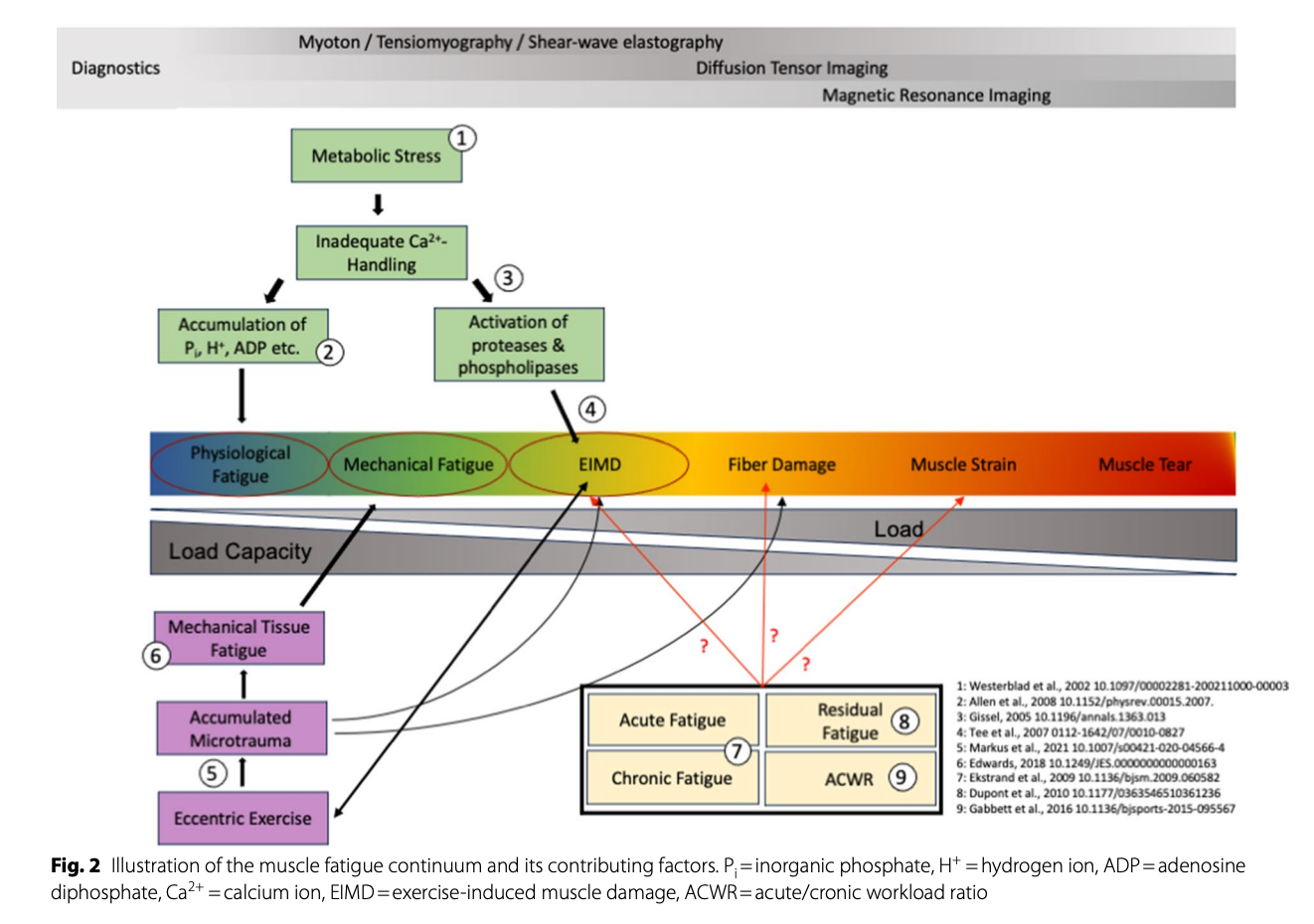A Better Framework for Load, Fatigue, and Injury
Despite advances in training science, load monitoring, and sports medicine, soft tissue injuries, especially muscle strains, remain common across all levels of sport.
The assumption has often been that fatigue and damage are separate physiological processes: fatigue involves energy depletion, while damage involves structural breakdown and failure.
However, new evidence suggests that muscle fatigue and muscle damage are not distinct, but rather points along a shared continuum of physiological stress.
This continuum begins with early signs of metabolic fatigue and can end with structural muscle failure if left unchecked.
This article breaks down the key concepts behind the Muscle Injury Continuum, including:
- How fatigue and damage overlap in real-world and lab settings
- The physiological mechanisms that link them
- How to assess where an athlete is on the continuum
- Strategies to monitor, manage, and adapt training accordingly
Beyond the Fatigue vs. Damage Binary
Traditionally, fatigue and damage were viewed through different lenses:
- Fatigue: A decline in performance due to metabolic stress (e.g., phosphate accumulation, impaired calcium handling, central drive)
- Damage: Structural disruption caused by mechanical overload (especially eccentric contractions), typically presenting as delayed-onset muscle soreness (DOMS) and elevated creatine kinase (CK)
However, emerging research shows considerable physiological and mechanical overlap:
- Fatigue can persist without classic markers of metabolic stress
- Damage can occur without high external forces, particularly with high-cycle, low-load activities
- Both states involve impaired calcium dynamics, enzyme leakage, inflammation, and reduced force production
This overlap challenges the idea that fatigue and damage are discrete, sequential phenomena.
Introducing the Muscle Injury Continuum
Rather than treating fatigue and damage as separate categories, this model proposes a progression along a single continuum. The stages include:
- Physiological Fatigue – Early, often transient reductions in contractile function
- Residual Fatigue – Persistent force deficits and slower recovery over days
- Mechanical Fatigue – Cumulative micro-stress on tissues from repeated loading
- Exercise-Induced Muscle Damage (EIMD) – Structural disruption without clinical injury
- Clinical Muscle Injury – Strains, tears, or ruptures
The position of a muscle along this continuum depends on both load history and current capacity.

Fatigue Contributes to Muscle Damage
Several mechanisms support the idea that fatigue increases vulnerability to damage:
- Prolonged Low-Frequency Force Depression: After eccentric fatigue, muscle force can remain suppressed for days, even without ongoing metabolic stress
- Altered Calcium Handling: Fatigue compromises calcium release and reuptake, reducing contractile efficiency and increasing susceptibility to microtrauma
- Mechanical Consequences of Fatigue: Fatigue alters joint kinematics, motor control, and fiber recruitment, all of which can shift strain to weaker tissues
Types of Fatigue and Implications
Understanding fatigue requires nuance. There are multiple types, each with different implications:
Acute Fatigue
- Occurs during or shortly after training or competition
- Often metabolic in nature
- Can alter biomechanics and motor patterns in real time
Residual Fatigue
- Lingers for 24–72 hours post-exercise
- Associated with reductions in eccentric strength and increased tightness
- Common when athletes train or compete with insufficient recovery
Chronic Fatigue
- Accumulates over weeks of repeated loading
- Can blunt performance, reduce resilience, and increase the risk of overuse
- Common in congested schedules and high-volume training phases
Inflammation and Enzyme Leakage
Fatigue and damage both provoke inflammatory responses, which are often more pronounced when they occur together:
- Interleukin-6 and TNF-α levels spike after marathon running and other endurance events
- Leukocyte accumulation in muscle tissue can delay recovery and increase soreness
- CK and myoglobin are released during both mechanical damage and metabolic overload
Enzyme leakage does not necessarily imply structural damage. In some cases, cells may "offload" enzymes like CK to protect themselves from metabolic death.
Lab Studies vs Real-World Evidence
Lab-based studies often fail to replicate the complex, multifactorial nature of fatigue and injury seen in sport:
- Many studies isolate concentric or eccentric tasks, while real sport involves rapid transitions between contraction types
- Laboratory fatigue protocols often underrepresent the mechanical chaos of actual gameplay
- Athletes display large individual differences in fatigue and damage responses that are hard to control for in research settings
While some laboratory studies suggest that fatigue has a protective effect against damage, real-world data tell a different story: injuries consistently increase under fatigue, particularly in late-game and late-season scenarios.
Monitoring and Managing the Continuum
To reduce injury risk, coaches and medical staff need tools to assess where an athlete is on the continuum.
Monitoring Strategies:
- Internal Load: sRPE, heart rate variability, subjective fatigue scales
- External Load: Volume, intensity, accelerations, decelerations, changes of direction
- Performance Testing:
- Jump testing (CMJ force-time metrics)
- Isometric strength assessments
- Tensiomyography (contraction time as proxy for fatigue)
- Biomarkers:
- CK and myoglobin for damage
- Lactate, ammonia, irisin for metabolic stress
Practical Applications:
- Build chronic workloads gradually to increase capacity
- Use post-exercise biomarkers and performance metrics to time recovery and loading
- Individualize training and return-to-play plans based on observed fatigue/damage profiles
Fatigue Is the Entry Point
The persistence of muscle injuries in elite sport may be due, in part, to a misunderstanding of fatigue.
Instead of viewing it as a short-term limitation, we should see fatigue as the entry point into a physiological process that, if unmanaged, can lead to structural failure.
The muscle injury continuum provides a more accurate, useful model to:
- Understand how fatigue and damage interact
- Recognize early warning signs
- Design smarter interventions for training, recovery, and return to play
This approach can help bridge the gap between research and real-world decision-making, ultimately reducing the risk of injury for the athletes we serve.
Reference
Schwiete C, Roth C, Mester J, Broich H, Behringer M. (2025). Overlaps of Skeletal Muscle Fatigue and Skeletal Muscle Damage: The Muscle Injury Continuum. Sports Medicine

